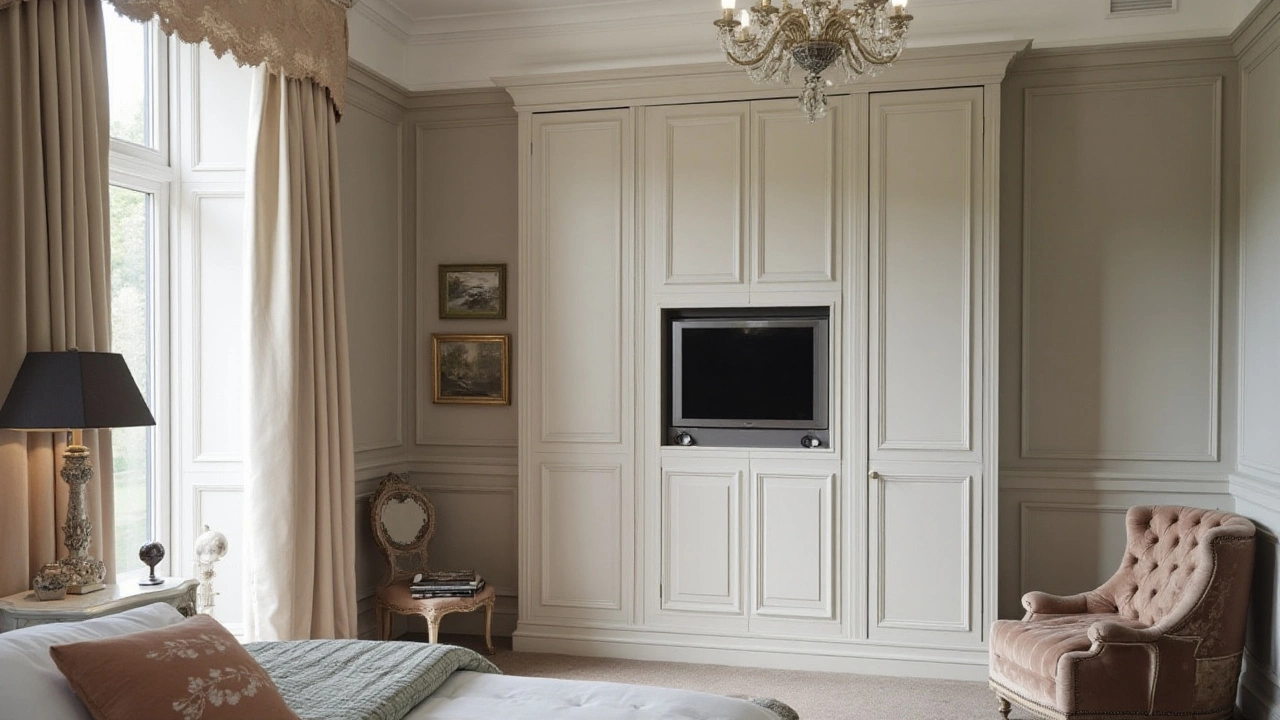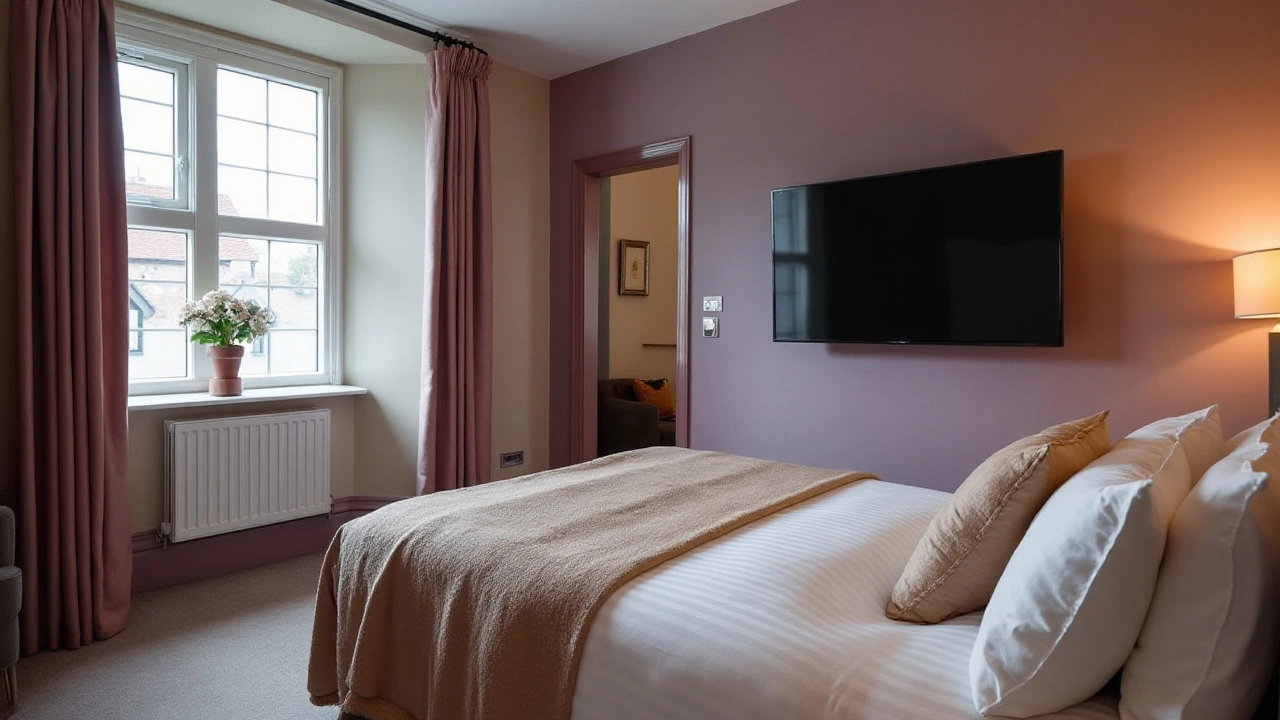Finding the perfect spot for a TV in your bedroom is an art that balances style with practicality. It's about more than just picking a wall or surface—it's about transforming your space into a cozy and efficient media nook. Whether you love binge-watching your favorite series or winding down with a late-night movie, the way you position your TV can enhance the experience.
Think about how you'll be watching the screen. Are you curling up in bed, or do you have a seating area to consider? Room layout, TV size, and even the type of mount or stand can make or break your setup. And let's not forget aesthetics—clever design can effortlessly integrate a TV into your room without sacrificing style.
- Finding the Best Viewing Angle
- Considering Bedroom Layout and Space
- Decorative Concealment and Integration Methods
- Adding Comfort and Smart Solutions
Finding the Best Viewing Angle
When it comes to positioning your TV in the bedroom, achieving the perfect viewing angle is crucial for both your eyes and your neck. The main goal is to have the center of the TV screen be at eye level when you’re in your most common viewing position. This can be from a seated position or even while lying down, depending on your personal habits. Viewing angles can impact picture quality too; the further off-angle you are, the worse the color and contrast may appear, especially on older TV models. Taking some time to adjust the height and angle can save you from straining your body and losing some viewing enjoyment.
One interesting fact is that a study suggests a TV should ideally be no higher than 15 degrees above your eye level for a comfortable view. This often means mounting the TV slightly lower than one might instinctively think. If wall-mounting isn't an option, consider adjustable mounts which offer great flexibility by allowing you to tilt or swivel the TV. It's also recommended to avoid direct sunlight on your viewing area because glare can diminish the clarity of the screen and cause unnecessary strain on the eyes.
"Many people don’t realize the impact a poorly positioned TV can have on their experience," says interior designer Janet Thompson. "An incorrect angle can lead to discomfort and spoil your relaxation time."
Sometimes, we may need to improvise for optimal viewing in a bedroom. Adjustable arm mounts or stands can be ideal solutions, especially in small rooms. These allow you to pull out, tilt, or even rotate your TV to find the best angle for your bedroom environment. And if you have multiple seating options, a swivel feature can be particularly beneficial. Such solutions not only enhance comfort but also account for different perspectives offered by various seating or lying positions.
Considering the space between the TV and your bed is also essential. The general rule of thumb is to maintain a distance that is two to three times the diagonal of your TV screen size. For instance, for a 42-inch TV, the optimal viewing distance would be about 7 feet. This distance ensures that you're not too close to the screen, which could cause eye discomfort, or too far away, where details become less vivid. Ensuring your TV is positioned at an optimal distance helps maintain an immersive experience without overwhelming the senses.
Importance of Room Layout
Your bedroom's layout significantly influences the positioning of your TV. Evaluate the natural line of sight from your bed or seating area and take into account any obstacles like furniture or decorations that might disrupt this line. It's beneficial to engage with the decor elements you already have and assess where changes can be made for seamless integration. This might mean rearranging furniture to avoid a cluttered feel and ensure no potential obstructions can lead to a lopsided or incomplete viewing.
Television setup is an important part of bedroom decor, impacting both aesthetics and the leisure quality of your space. Thoughtful consideration of these factors now will create a more enjoyable environment for those quiet nights spent binge-watching or taking in the evening's news before sleep. Let the TV complement your sanctuary, not hinder it, and imbue your bedroom with both comfort and style as you find your ultimate viewing pleasure.
Considering Bedroom Layout and Space
When you're planning where to place your TV in the bedroom, taking a moment to consider your bedroom's layout and how much space you have is crucial. Bedrooms are often sanctuaries where we retreat from the daily hustle and bustle—design choices here should cater to both relaxation and practicality. You can enhance the room's design without overwhelming it by closely examining where furniture placement naturally leads your gaze. It's beneficial to think about the flow of the room; examine how people move around the space, how furniture is already laid out, and where natural sightlines exist. This way, you ensure that the TV doesn’t compete with other elements in the room or disrupt movement.
It's a familiar scenario: trying to balance functionality and aesthetics in a space where there's often not much room to work with. For smaller rooms, wall mounting the TV can be a game changer. It saves precious floor space while providing a sleek, modern look. For those who are eager to dive into DIY, wall mounts come in a variety of types, from fixed brackets to ones that tilt and swivel, allowing you to adjust according to your viewing needs. An article in Architectural Digest once stated,
"Wall mounting your TV is often the smartest choice for smaller bedroom layouts, as it maximizes floor space while allowing room for other essential bedroom furniture.”This insight can be key for those struggling to fit all their essentials into a compact room.
The angle and height of your television setup play vital roles too. Aim to position the TV at eye level when you're in your usual viewing spot, whether that's lounging in bed or sitting in a chair. The goal is to avoid neck strain, creating a gulf between comfort and pleasure. Remember, if you need to tilt your head up or down significantly, moving the TV is likely in your future. In larger bedrooms, the spaciousness opens up more options. Considerations like incorporating a TV stand or using a media console can add to the room’s decor while providing storage options to help keep the space tidy. This might make sense if your bed isn't directly facing a wall where a TV could be mounted. This choice can double as an aesthetic piece, contributing to the room when the TV is off.
You might find it useful to consider transforming the TV into a part of a gallery wall. This can soften the presence of a large black screen within your stylish bedroom decor. Placing your TV among artwork allows it to blend in and feel less imposing. Besides, with advancing technologies, modern TVs often come with screensaver modes that display art or photos, enhancing this idea even more. Notably, consider the lighting situation in the room. Bright glare from natural or artificial light can drastically affect viewing pleasure. If your bedroom is sun-drenched, investing in blackout curtains or blinds could minimize glare and maximize your viewing experience. Balancing lighting carefully can make your TV time more enjoyable.

Decorative Concealment and Integration Methods
In the realm of bedroom decor, integrating a TV without letting it dominate the space is a common challenge. Many designers favor subtlety, advocating for the television to be a functional yet discreet element of the interior. One popular approach is using a framed cabinet or entertainment center. These pieces offer the practical benefit of housing the TV as well as creating storage for electronics, all while blending with the room's aesthetic. The variety in styles—from rustic wood finishes to sleek, modern designs—allows homeowners to match their bedroom's existing look seamlessly.
Another effective method is incorporating a TV into a feature wall. This might involve a palette of soft textures or patterned wallpapers, so even when the screen is off, the wall remains visually appealing. It's as if the TV has been transformed into an art piece, waiting patiently for its moment in the spotlight. A rising trend is the use of mechanical lifts, which can hide the television in cabinetry when not in use. These devices offer an element of surprise and luxury by providing movement and elegance in a creative way.
A more tech-savvy solution employs the use of specialty glass or mirror TVs. With a touch of a button, these screens transform from showing the latest episode of your favorite series into just another reflective surface of your room, practically disappearing when off. Some experts consider this the holy grail of TV camouflage for smaller spaces.
"Integrating technology into decor thoughtfully requires more than just clever tricks; it demands an understanding of how people live and what they find visually inspiring," remarks Elle Decor’s design editor.
For those with an artistic bent, a gallery wall around the TV can do wonders. By surrounding the screen with a collection of pictures, frames, and prints, you can successfully incorporate the TV as just another element in a curated display. Not only does this make the device less obtrusive, but it also infuses a personal touch, allowing the room to tell a story through art and family photos. Paintings or prints that resonate with your personal style or memories can set the tone for a truly unique room.
To further enhance these methods, consider employing sound systems that blend into decor, like invisible speakers flush with the walls, ensuring audio quality without clunky gadgets marring the aesthetic. The future of TV integration blends technological sophistication with home interior design, all while keeping the viewer's experience in mind. No matter which method you choose, keep in mind that the ultimate goal is to create a harmonious environment where technology enhances rather than intrudes, turning your bedroom into a personalized sanctuary.
Adding Comfort and Smart Solutions
Integrating comfort and technology into your bedroom TV placement ensures not only an enjoyable viewing experience but a blend of modern convenience and coziness. First, consider the viewing height; wall mounts with adjustable arms allow you to modify the television's position to your liking. Whether relaxing in bed or seated on a side chair, the ability to adjust the angle can prevent neck strain, contributing to a more comfortable setting. This flexibility does not come at the cost of style, as myriad elegant mount designs complement various bedroom aesthetics.
Delving into the realm of smart solutions, voice-activated devices are becoming increasingly popular. Implementing a voice assistant or smart home system can revolutionize the way you interact with your bedroom television setup. Whether it's a simple voice command to adjust volume or switch channels, these technologies simplify your life and enhance comfort. This transformation aligns with the latest trends in smart home integration, making your personal sanctuary future-ready. Additionally, some smart TVs now come with health and wellness apps, promoting a holistic lifestyle right from your bedroom.
For those who love numbers, integrating data about optimal sound and visual settings can assist in honing your comfort. According to recent statistics, settings that maintain a 15-20-degree downward angle can significantly reduce eye and neck strain during extended viewing periods. You might not know this, but a perfectly balanced setting ensures that your TV's brightness and sound levels do not overwhelm, instead complementing your bedroom ambiance.
Moreover, maximizing comfort sometimes involves a practical review of furnishings and layouts. A plush, ergonomic chair with a throw pillow, strategically positioned within earshot and eyeshot of the TV, provides an alternative to lounging in bed. It offers a new perspective and comfort level for viewing, particularly appealing if your bedroom serves as a multi-functional space. Employ this idea to diversify your viewing experiences and add a touch of luxury to every movie night.
Embracing Innovation
Innovation should never be an afterthought. As technology evolves, so too do the opportunities for incredible comfort. For those looking to stay ahead of the curve, exploring options like OLED displays or surround sound systems can bolster your home interior without overwhelming the space. Remember, simplicity is key; integrate solutions seamlessly rather than overwhelm with gadgets. As Leo Tolstoy famously penned, "A quiet, secluded life in the country, with the possibility of being useful to people... then work which one hopes may be of some use; then rest, nature, books, music, love for one's neighbor—such is my idea of happiness." A balanced approach to technology and comfort is crucial to achieving true harmony.


